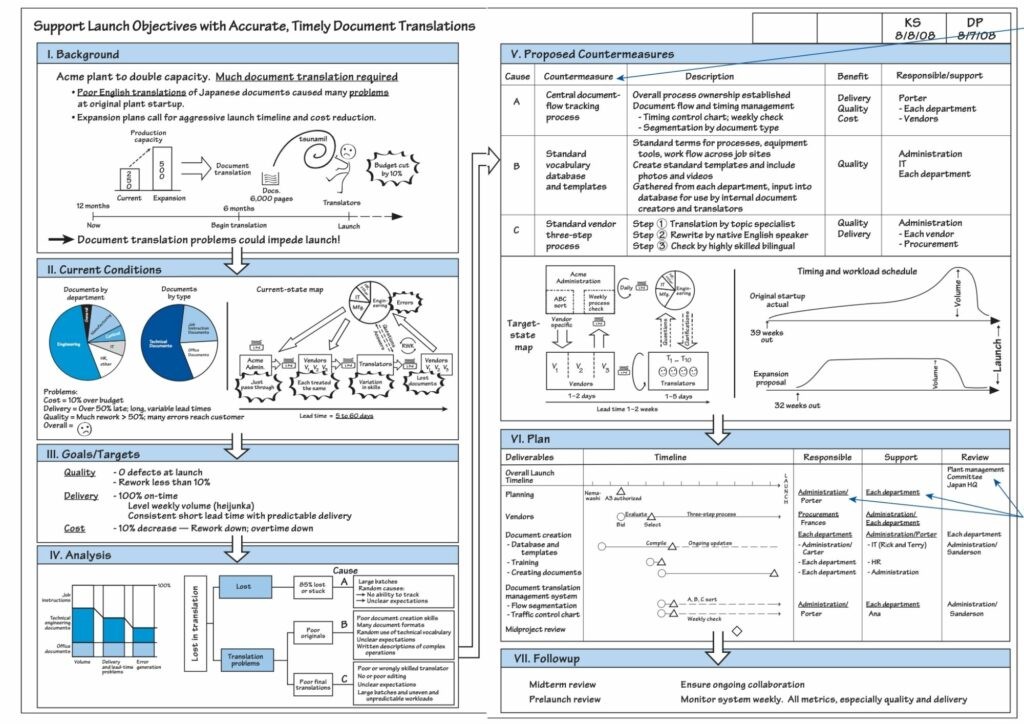The A3 report, a concept pioneered by Toyota, is a structured yet simple approach to problem-solving and process improvement. It’s named after the international standard A3 paper size (similar to 11×17 inch tabloid paper in the U.S.), which dictates that the entire problem-solving process—including the problem, analysis, proposed solutions, and action plan—should be concisely summarized on a single sheet. More than just a document, the A3 Toyota method represents a dynamic management process fostered through dialogue and collaborative problem exploration.
This methodology facilitates a learning environment where managers and team members engage in constructive conversations around specific challenges. The A3 analysis becomes a tool for developing employees, enhancing their problem-solving skills, and fostering leadership qualities—a cornerstone of the Toyota management philosophy. An A3 report effectively guides discussions and analysis, clearly defining the current situation, the nature of the problem, potential countermeasures, the chosen solution, implementation plans (detailing who, what, and when), and the verification method to ensure the issue is resolved.
“The lean leader’s job is to develop people. If the worker hasn’t learned, the teacher hasn’t taught.”
Training Within Industry Report (Washington, DC: War Manpower Commission, Bureau of Training, 1945).
Shifting from Debate to Dialogue with A3 Thinking
One of the significant advantages of employing the A3 process is its ability to shift organizational dynamics from authority-driven debates to responsibility-focused dialogues. Instead of discussions centered around “who is in charge,” the A3 encourages conversations about “what is the right course of action.” This fundamentally changes decision-making processes. Individuals earn the authority to act based on the strength of their problem framing, which is rooted in factual evidence gathered directly from the gemba – the actual place where work is done. By emphasizing indisputable facts and data derived from firsthand observation, A3 promotes consensus and informed decision-making.
Therefore, A3 management transcends traditional hierarchical models. It’s neither strictly “top-down” nor “bottom-up.” The A3 process clarifies accountability by assigning clear ownership to the report’s author, identified in the document’s upper right corner. This owner, while not necessarily possessing direct authority over all aspects of the proposed solution, assumes responsibility for driving decisions and ensuring implementation. The A3 framework empowers individuals to take initiative and ownership in problem-solving, contributing to a more proactive and efficient organizational culture.
Examples of A3 Reports in Action
To illustrate the versatility of A3 reports, consider these examples across different domains:
Example of a completed A3 report detailing the resolution of a translation-related administrative issue.
A manufacturing problem-solving scenario documented in a completed A3 report format.
Event planning and execution challenges addressed and documented using an A3 report.
These examples demonstrate that the A3 methodology is not confined to a specific industry or problem type. It can be effectively applied to administrative, manufacturing, event planning, and countless other scenarios.
The Multifaceted Nature of the A3 Approach
The term “A3” encompasses various dimensions, making it a rich and adaptable tool:
-
Standard Paper Size: At its core, A3 refers to a specific paper dimension (297mm x 420mm), promoting concise communication.
-
Not a Template, but a Framework: While templates exist to guide A3 creation, the essence of A3 is not the template itself but the structured thinking process it encourages.
-
Communication Storyboard: As an A3 evolves, it becomes a visual storyboard, facilitating communication and collaboration among stakeholders by presenting all relevant information in a logical and summarized manner.
-
Problem-Solving Report: Upon completion, the A3 serves as a comprehensive report documenting the entire problem-solving journey, from initial analysis to implemented countermeasures and results.
-
Structured Problem-Solving Process: A3 is fundamentally a step-by-step problem-solving methodology. It typically divides the A3 sheet into sections, with the left side dedicated to problem definition and analysis, and the right side focusing on solutions and implementation.
-
Management and Coaching Tool: Leaders utilize A3 as a framework to guide and mentor team members. Through A3-guided dialogues, leaders coach subordinates in lean thinking and problem-solving, fostering their development by asking questions rather than providing ready-made answers.
-
A3 Thinking Methodology: Beyond the physical report, “A3 thinking” refers to a systematic and logical approach to problem resolution, applicable even without formally creating an A3 document.
-
Strategic Alignment Tool: In organizations deeply rooted in lean principles, A3 reports become integral to strategy deployment, ensuring a standardized approach to problem-solving and coaching that aligns with overarching organizational goals.
A3 Templates for Practical Application
To get started with A3 reporting, consider utilizing these templates:
Strategy A3 Template for strategic planning and alignment.
Download
Detailed A3 Template outlining key components for comprehensive problem-solving.
Download
Further Resources for Mastering A3 Reports
Expand your understanding of A3 reports with these valuable resources:
Article
How Do I Start My A3?
This article emphasizes that effective A3 creation begins with thoughtful analysis and understanding the problem, rather than simply writing.
Article
Don’t Present Your A3: Share Your A3
This resource highlights the collaborative nature of A3 reports, advocating for sharing and discussion over formal presentations.
Enhance Your Problem-Solving Skills
Intro to Problem Solving
Develop essential problem-solving skills applicable across industries. Learn to deeply understand situations at the gemba and effectively analyze root causes.
Learn more
Synonyms: A3, A3 Toyota, A3 Analysis
Related Concepts: Value Stream Mapping
In conclusion, the A3 report, originating from Toyota’s renowned management system, is more than just a document; it’s a powerful methodology for structured problem-solving, communication, and employee development. By embracing A3 thinking, organizations can cultivate a culture of continuous improvement, fact-based decision-making, and shared responsibility.

